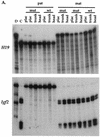Multiple mechanisms regulate imprinting of the mouse distal chromosome 7 gene cluster
- PMID: 9584186
- PMCID: PMC108927
- DOI: 10.1128/MCB.18.6.3466
Multiple mechanisms regulate imprinting of the mouse distal chromosome 7 gene cluster
Abstract
Genomic imprinting is an epigenetic process that results in the preferential silencing of one of the two parental copies of a gene. Although the precise mechanisms by which genomic imprinting occurs are unknown, the tendency of imprinted genes to exist in chromosomal clusters suggests long-range regulation through shared regulatory elements. We characterize a 800-kb region on the distal end of mouse chromosome 7 that contains a cluster of four maternally expressed genes, H19, Mash2, Kvlqt1, and p57(Kip2), as well as two paternally expressed genes, Igf2 and Ins2, and assess the expression and imprinting of Mash2, Kvlqt1, and p57(Kip2) during development in embryonic and extraembryonic tissues. Unlike Igf2 and Ins2, which depend on H19 for their imprinting, Mash2, p57(Kip2), and Kvlqt1 are unaffected by a deletion of the H19 gene region, suggesting that these more telomeric genes are not regulated by the mechanism that controls H19, Igf2, and Ins2. Mutations in human p57(Kip2) have been implicated in Beckwith-Wiedemann syndrome, a disease that has also been associated with loss of imprinting of IGF2. We find, however, that a deletion of the gene has no effect on imprinting within the cluster. Surprisingly, the three maternally expressed genes are regulated very differently by DNA methylation; p57(Kip2) is activated, Kvlqt1 is silenced, and Mash2 is unaffected in mice lacking DNA methyltransferase. We conclude that H19 is not a global regulator of imprinting on distal chromosome 7 and that the telomeric genes are imprinted by a separate mechanism(s).
Figures






References
-
- Auffray C, Rougeon F. Purification of mouse immunoglobulin heavy-chain messenger RNAs from total myeloma tumor RNA. Eur J Biochem. 1980;107:303–314. - PubMed
-
- Ausubel F M, Brent R, Kingston R E, Moore D D, Seidman J G, Smith J A, Struhl K, editors. Current protocols in molecular biology. Vol. 1. New York, N.Y: John Wiley & Sons, Inc.; 1988.
-
- Bartolomei M S, Tilghman S M. Genomic imprinting in mammals. Annu Rev Genet. 1997;31:493–525. - PubMed
-
- Bartolomei M S, Webber A L, Brunkow M E, Tilghman S M. Epigenetic mechanisms underlying the imprinting of the mouse H19 gene. Genes Dev. 1993;7:1663–1673. - PubMed
Publication types
MeSH terms
Substances
Grants and funding
LinkOut - more resources
Full Text Sources
Molecular Biology Databases
Miscellaneous
